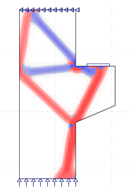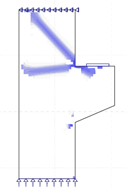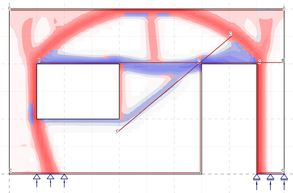Highlights
IDEA StatiCa Detail is a bran-new application which brings the next chapter in simplifying and improving your design process of concrete members.
- Safe and economical design based on valid standards
- Topology optimization - design of positions and directions of the reinforcement
- Input, design and code checks in 15 minutes
- General solution – a combination of various forms of discontinuity
- Any topology of detail/wall
- Detail results
- Link to IDEA StatiCa Beam/BIM
Scope
Concrete beams, walls, and columns have parts with some form of discontinuity (D) - opening, dapped end, bracket, hanged loads, anchorage, the area above support, etc. In spite of discontinuity regions are present in every concrete structure, no single solution exists so far for the complete design of concrete details, walls, and diaphragms.
B a D regions
D regions in the transition of the column support system to the wall
Single-purpose, specialized programs or Excel design sheets based on strut and tie method are currently used for the design of discontinuity regions. Conversely, scientifically oriented programs might exceptionally be used with no link-up with national standards and regulations, and without the design and optimization of the reinforcement. This practice leads to oversimplifications or on the contrary to attempt to simulate reality. None of those methods can be used for a concept-decision analysis of the structure or its detail as they require accurate dimensions, location directions and amount of reinforcement in advance. The author’s experience is that even professionals have inadequate knowledge when it comes to the problem of the determination of positions and directions of the reinforcement in cases of atypical details of concrete structures.
Our Solution
The new software tool IDEA StatiCa Detail allows engineers to propose appropriate concrete dimensions as well as location and amount of reinforcement in an efficient way, providing safe and economical designs based on valid standards. The verification of our cutting-edge technology has been done against code independent cases as well as with existing codes with material laws as defined in the codes.
IDEA StatiCa introduces a novel way to design and check concrete details and walls. With it, engineers can break the limits of standard design tools to save time and optimize material usage. Clear pass/fail checks according to the code are available in minutes, as well as complete output reports
Design process
Model with constraints and load
Topology optimization
Compression parts filtered out
Model with added reinforcement
Code checks
Geometry, loads, reinforcement
ULS check
Check of anchorage
Tensile stress fields
Reinforcement Design
The use of the topology optimization method may be of great help in reinforcement design. It can be used to generate a geometry by using only a certain percentage of the original material volume and rearranging it in a way that is “most effective” for the given set of loads, according to some criteria. This may result in a structure, which may be used as an accurate guide tool to identify the areas of tension and compression of the original concrete structure. This process is not much unlike the commonly used strut-and-tie method, but using this method, it can be done automatically, with much less need for human reflection and trial and error.
Wall with door and window
Topology optimization result
Model with added reinforcement
Result of non-linear analysis, red – stress in compressed concrete, blue – forces in reinforcement bars
Dapped end with haunch and opening
Results of topology optimization
3D view of a reinforced member
Although the results yielded by the topology optimization method still require some level of an engineer’s reflection and interpretation, it represents a fast and easy to use tool that can facilitate and speed up the task of reinforcement design significantly. Especially in cases of non-typical structures and/or multiple load cases, it can lead to results that would not otherwise be obvious, if conventional methods were used. This can result in savings not only in engineering time but also in the amount of reinforcement steel that needs to be used.
Cutting-edge technology
Code independent, at the same time code complying
- Fictitious rotating stress-free cracks
- Tension chord model
- Tension stiffening
- Limit strain in tension
- Ductility verification
- Compression softening
- Bond & anchorage model






















